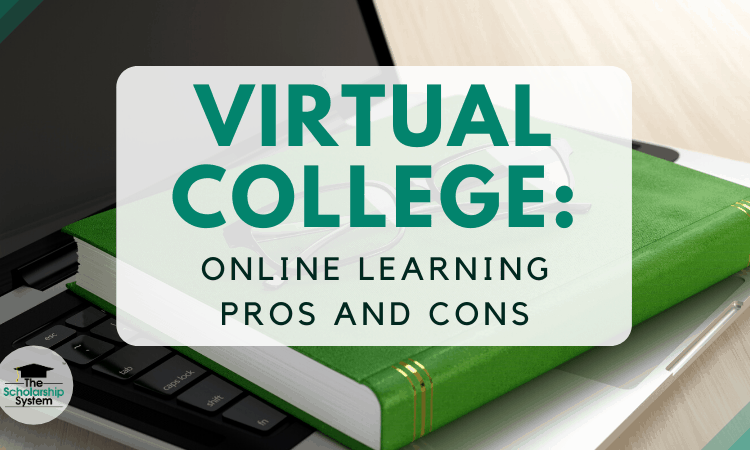Updated on July 21st, 2022
Most college students have a choice; they can attend classes in person or go to school virtually. Before your student chooses a direction (or decides to take a COVID-19 gap year to avoid having to take web-based classes), there are online learning pros and cons to consider.
For many students, online courses are incredibly convenient. During the coronavirus pandemic, virtual learning opportunities allowed students to continue moving forward, a boon considering the suddenness at which colleges had to close.
However, for some, the experience isn’t ideal. There are some important issues to examine with the virtual paradigm, as well as points in the online learning vs. classroom learning debate. With that in mind, here’s a look at the online learning pros and cons, as well as an overview of what online learning is and whether it’s a better option than classroom learning.
If you and your student want to learn about how to find scholarships, ensuring that their ideal school is affordable, sign up for our free college scholarship webinar! Take a trip over to https://thescholarshipsystem.com/freewebinar to reserve your spot today.
Contents
What Is Online Learning?
Online learning, at its simplest, is an educational opportunity that takes place over the internet. For example, webinars with live instructors are online learning, as well as entirely text-based modules that professors don’t host. As long as the educational experience is facilitated by technology and students connect using the internet, it potentially qualifies.
Many people are surprised to learn that there are actually a few distance learning approaches that students may encounter, as well, including asynchronous, synchronous, and hybrid approaches.
With asynchronous learning, students can proceed (at least, to a degree) at their own pace. For example, they may be able to log in and complete coursework at any time, day or night.
Synchronous learning is highly coordinated and is the favored approach for instructor-led courses. Students participate in class at the same time, logging into webinars, video conferences, or chatrooms based on a class schedule.
With the hybrid learning approach, classes use some aspects of asynchronous and synchronous experiences. For instance, students might review the course materials on their own time but also have to complete assignments by set due dates. Technically, any blended method is hybrid learning, so the model can vary significantly from one school to the next.
Related Video: Scholarships for Online Students: Are They Available?
Online Learning Pros and Cons
As with any educational approach, online learning comes with its own set of benefits and drawbacks. In some ways, virtual courses actually outshine traditional classroom experiences. However, online college isn’t universally ideal.
By understanding the online learning pros and cons, students can better decide whether virtual or in-person learning is the right approach for them. Here’s a breakdown of the benefits and drawbacks of virtual college courses.
Benefits of Online Learning
More Flexibility
The most significant benefit of online learning is a degree of flexibility. In many cases, online courses that embrace either the asynchronous or hybrid model don’t require students to log in at a specific time. Instead, students access materials at times that suit them best. As long as the assignments are done by the due date, when the student handles the work is irrelevant.
For some, the arrangement above is ideal. Students can adapt their college experience, allowing them to manage other responsibilities, like working or family obligations.
Even if students need to log in during a particular window, there’s still some flexibility in the approach. Students can participate from anywhere as long as they have a capable device and an internet connection. That can also make it easier to fit in college if your student has a busy schedule.
Potential Cost-Savings
In many cases, online courses are more affordable than their in-person counterparts. Typically, students don’t have to buy physical textbooks, scantrons, or many other common supplies. Instead, the entire experience is virtual, including textbooks, tests, and more.
Additionally, if your student pursues a degree and only attends classes online, they may avoid specific fees. For example, since your student isn’t using various resources – like student centers, labs, and libraries – their total college bill may be lower. Even if they have to pay a technology fee, the total cost may still be less than the alternative.
Finally, certain personal expenses may also diminish. For instance, by not going to a campus, your student doesn’t have to pay for room and board or commuting costs and parking fees.
Degree of Autonomy
With asynchronous or hybrid learning online courses, your student can personalize their experience, to a degree. Often, students can move as quickly as they’d like, which may be ideal for students who tend to learn faster than their counterparts.
Plus, it creates an opportunity to acquire or hone some valuable soft skills. Time management, self-reliance, accountability, and organization are all part of the online learning experience, especially if attendance or due date requirements are loose.
Opportunity Beyond Location
One of the most significant benefits your student can experience (and a major point in the online learning vs. classroom learning pros and cons debate) is not being bound by location. Since online coursework can be completed anywhere, students enroll at schools that would otherwise be too far away or impractical to attend.
Not all students have the ability to leave home for college. For example, if a student is a primary caregiver for a family member who can’t relocate, they need to attend college locally. With online courses, students can enroll at schools in other cities, states, or countries, all while staying where they are physically located. This gives them access to opportunities that otherwise wouldn’t be available.
Drawbacks of Online Learning
Limited Interaction
The biggest drawback of online learning is a lack of interaction. While online courses usually try to encourage students to engage with each other and their professors, collaboration is challenging to manage. Getting everyone together might not be plausible, especially if the class is mainly asynchronous. Delays in getting answers to questions are also common, as a knowledgeable person might not be available at the moment your student reaches out.
Similarly, online learning lacks the social component of the college experience, something many students value. Interactions typically aren’t organic; there’s no casual chatting in the hall or sharing laughs while walking to the next class. Instead, most conversations are planned and scheduled and may be highly focused on the task-at-hand.
Lack of Networking Opportunities
Along the same line, professional networking opportunities may be limited when your student goes to college virtually. Largely, this is due to the limited interaction, which can prevent students from bonding with professors or classmates who may otherwise be able to help them advance their careers.
Accountability, Motivation, and Time Management Challenges
To succeed in an online course, students have to be highly self-motivated. This is especially true for asynchronous classes where there aren’t rigid due dates or well-defined expectations.
Some students will struggle with accountability and time management, as well. Since no one is telling them what needs to happen when, they may not develop a sense of urgency. This could cause them to fall behind, hindering their ability to move forward with their degree efficiently.
Potential Reputation Issues
If your student chooses a “non-traditional” school for their online coursework, they may face an uphill battle once they have a degree. Some all-online or predominately online colleges carry with them a stigma (which may or may not be deserved), causing some employers to look down on graduates from those schools.
However, online courses from traditional colleges or universities typically don’t have this issue. The reputation question is usually school-specific and isn’t based on the fact that the work was done virtually.
Online Learning vs. Classroom Learning: Which Is Better?
Ultimately, online learning and classroom learning both have their benefits and drawbacks. Neither is inherently better than the other, though one may be a stronger fit for specific students.
Your student needs to consider their learning needs and personal capabilities. If they work well independently, pick up topics quickly, require little support from professors, and have excellent time management, organizational, and similar skills, they may thrive online. Similarly, if your student wants to attend a college away from home but can’t actually relocate, virtual programs may make their dream school an option.
However, if the social component of college is important to them, they need access to one-on-one support from instructors, or they need a clear structure, then they may be better off heading into an actual classroom. That way, they can have greater access to people and well-defined expectations, increasing the odds they’ll get the support and guidance they need to excel.
If you and your student want to learn about how to find scholarships, ensuring that their ideal school is affordable, sign up for our free college scholarship webinar! Take a trip over to https://thescholarshipsystem.com/freewebinar to reserve your spot today.








I like that you pointed out how the most significant benefit of online learning is a degree of flexibility. My brother is planning to study again, however, he also has a job right now. Going to campus is not an option, so maybe he should try an online biblical college.